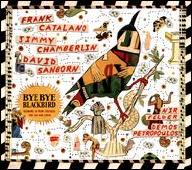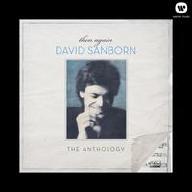Sanborn was born in Tampa, Florida, but raised in Kirkwood, Missouri, a suburb of St. Louis. Contracting polio at the age of three, he struggled with the disease for eight years. In its aftermath, he began to play saxophone on the advice of a doctor, who thought it would aid him in strengthening his chest muscles.
Sanborn's practice sessions became marathons. His first major influence on the alto was Hank Crawford, whose openly emotional tone he admired. The youngster made his professional debut at the age of 14 in 1959, playing with visiting Chicago bluesmen Little Milton and Albert King.
Sanborn later traveled to California and met Paul Butterfield in 1965. After relocating to the Bay Area, he joined the Butterfield Blues Band. He appeared with them at Woodstock and went on to record with them. He began a long association with Gil Evans while simultaneously playing as a sessionman. Some of the classic records he played on during the era include Bobby Charles' eponymous album, Stevie Wonder's Talking Book, Todd Rundgren's A Wizard, A True Star, David Bowie's Young Americans (the iconic solo on the title track is his), Tommy Bolin's Teaser, James Taylor's You Make It Easy, and Michael Franks' The Art of Tea. During the rest of the decade, he cut two more albums and worked live and in the studio with a dizzying array of artists from Steve Forbert and Ian Hunter to Chaka Khan, the Fania All-Stars, and Bonnie Raitt.
Relocating to New York, Sanborn's first real break as a leader came with 1980's Hideaway, which hit number two on the Jazz Albums chart and number 33 on the R&B Albums chart and marked the beginning of a long association with bassist/producer Marcus Miller. It was the dawn of smooth jazz. He followed it with Voyeur a year later. The album's single, "All I Need Is You," netted him his first Grammy Award for Best R&B Instrumental Performance. The full-length was the first of four straight '80s albums to hit the top spot on the jazz charts. In 1983, he recorded As We Speak, Backstreet (with Luther Vandross as guest vocalist), and Straight to the Heart.
Interestingly, despite the rigorous demands of touring and recording that chart success demanded, Sanborn remained committed to playing on records by other artists (Billy Joel, Rickie Lee Jones, and George Benson among them). He also continued his live and recording work with Evans. 1987's A Change of Heart topped out at number three on the jazz charts.
In 1988, Sanborn began hosting Night Music, a cult TV show where invited musical guests performed their own work, discussed it in depth with the host, and jammed with the house band under musical directors like Marcus Miller and George Duke. Canceled after two seasons, it has since developed a reputation as one of the finest musical series in television history.
Though he had been composing film scores since 1975 (Moment to Moment), his career in this medium took off in 1986 with Psycho III. From the late '80s to the mid-'90s he also wrote scores for Lethal Weapon 2, 3, and 4. He became a regular guest of Paul Schaeffer's band on Late Night with David Letterman and co-hosted the television program Night Music with sidekick and pianist Jools Holland. The eclectic program, which ran in 1988 and 1989, featured guests Sonny Rollins, Marianne Faithfull, Jaco Pastorius, Sonic Youth, Taylor Dayne, John Zorn, Iggy Pop, and Sun Ra, to name a few.
In 1991 he moved over to Elektra and released Another Hand, which became his most revered album among jazz fans. Produced by Hal Willner, it featured a band consisting of Bill Frisell, Charlie Haden, Jack DeJohnette, and Marc Ribot. He followed it with Upfront, the hard-grooving, bluesy soul-jazz set that placed more emphasis on the Hammond B-3 than his saxophone and featured guest spots by William Spaceman Patterson and Eric Clapton. 1994's Hearsay bridged the musical gap between the two previous albums but was a funkier, larger band date overall. The decade saw him shift toward his own music more than session appearances, but he still made plenty, including dates with Dave Stewart, Oleta Adams, and Branford Marsalis' Buckshot LeFonque.
Sanborn shifted gears again for 1995's Hearsay, a collection of standards with Johnny Mandel's orchestra which revealed yet another side of the altoist. Inside, released in 1999, was another large-scope project and featured a host of vocalists including Cassandra Wilson, Sting, Lalah Hathaway, and Eric Benet. It garnered Sanborn the Grammy for Best Contemporary Jazz Performance.
Sanborn moved to Verve for 2003's Time Again, a contemporary collection of pop, R&B, and jazz standards which was notable for covers of "Cristo Redentor," "Harlem Nocturne," and "Isn't She Lovely." He followed that vein for 2005's Closer, which focused more on jazz standards with an understated electric band. He pulled out all the stops on Here Gone, a gritty, soulful, rocking tribute to Ray Charles in 2008 with guests including Sam Moore, Derek Trucks, Eric Clapton, and Joss Stone, and released a sequel with 2010's Only Everything.
In 2013, Sanborn teamed with Bob James to co-lead on Quartette Humaine, a collection of funky contemporary jazz and more thoughtful post-bop sounds that also featured bassist James Genus and drummer Steve Gadd.
The following year he was a member of the four-person quartet that released Enjoy the View for Blue Note. His co-leaders were Bobby Hutcherson, Joey DeFrancesco, and drummer Billy Hart.
Playing regular gigs on Letterman and performing live all over the globe, the saxophonist embarked on a Pledge Music campaign to fund his 25th release. He reunited with Miller as both producer and bassist -- it was the pair's first collaboration in 15 years. The finished album featured Sanborn in a large group setting with guest vocal appearances by Randy Crawford and Tower of Power's Larry Braggs. The set was issued by Sony/Okeh in the spring of 2015 as Time the River.
After more touring and session work, the saxophonist, working in his home studio in New York, created the Sanborn Sessions in 2019. It is an internet broadcast that extends musical terrain carved out by Night Music nearly two decades before: guests perform their own music and jam with Sanborn's house band. Early guests included Kandace Springs, Michael McDonald, Terrace Martin, and Bob James. In July of 2020, to mark the occasion of Sanborn's 75th birthday, the U.K.'s Soul Music label issued the three-disc retrospective Anything You Want (The Warner-Reprise-Elektra Years 1975-1999). Compiled by A. Scott Galloway, the 45 tracks including rare mixes, radio edits, overlooked album tracks, and live versions drawn from the 17 solo albums Sanborn recorded during that 25-year period. ~ Thom Jurek, Rovi
|
1
|
|
Maputo |
|
2
|
|
The Dream |
|
3
|
|
Chicago Song |


















